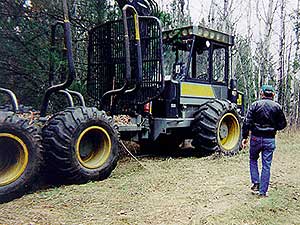|
Audio
Photos
More from MPR
Resources
|
January 12, 2005
 |
| Heavy equipment like this log hauler is used to harvest Minnesota timber. (MPR Photo/Bob Kelleher) |
Duluth, Minn. — Blandin's new paper machine would consume another 200,000 cords of pulp wood a year -- mostly aspen, with lesser amounts of balsam fir and spruce.
By the numbers, that should be little problem. The state's overall timber harvest has declined over the past decade -- holding at less than four million cords a year. That's below a level that can be sustained, according to the General Environmental Impact Statement on timber harvesting, better known as the GEIS.
The GEIS was put together 11 years ago to balance the needs of what was then an expanding timber industry with environmental concerns.
But the GEIS makes assumptions about improved forest management and harvest practices to support sustainable forestry. The Sierra Club's Clyde Hanson says those assumptions haven't all come true.
"The mills promised logging reforms when they expanded a decade ago, but their promises were never kept," Hanson says. "So the question is, do we want to trash our wild heritage just to keep the ad rates down for People magazine?"
Hanson says plans to manage large forested regions as single units have been coming along far too slowly. The state is just now completing its landscape management plan for the last of the state's six forested regions. Coordinating those plans with public and private landowners will take yet more time.
Matt Norton shares Hanson's frustration. Norton directs the Minnesota Center for Environmental Advocacy. Norton says some improved logging practices have been widely adopted, but others have not.
"The problem is that many of the mitigations have not been implemented, or, in some cases, really fully begun," says Norton. "We have in some areas just processes in place. Eleven years after the GEIS is finished, we don't have the mitigations put into place that were called for, and that the GEIS said should be begun immediately."
He says there's still disagreement over how much forest to leave untouched in riparian zones -- the areas that border lakes and streams. And he says studies have found ongoing problems with rutting from logging equipment. Ruts cause soil damage and erosion.
"The state really does need more resources to get this job done," Norton says. "We do not have enough people in the DNR working on these things. And so it is a question of resources and priorities."
Whether the GEIS has been effective is a matter of interpretation, but in Norton's view, the glass is still partly empty.
"Mitigations delayed here are, in some respects, mitigations denied," Norton says.
To the forest industry's Wayne Brandt, the glass is mostly full.
"I think the assertions that the mitigations from the GEIS have not been robustly embraced are just dead wrong," says Brandt.
Brandt directs the Minnesota Timber Producers and Minnesota Forest Industries. Brandt says loggers began adopting better practices even before the new rules were published.
"People just began implementing, saying in essence, 'You know, that's a good prescription. That's a good management practice. We're not going to wait for some book to be printed and distributed. We're going to start doing that now.' So we've seen that, and we continue to see improvements in the use of those practices," Brandt says.
He says more than 90 percent of the state's loggers and logging companies have been trained in sustainable forest practices.
Dave Zumeta directs the Minnesota Forest Resources Council, the group that works to get best management practices in play.
"Obviously, opinions vary as to have we done everything that is necessary," says Zumeta. "And, would we like to do more, given better fiscal times? Sure. We have done a lot. We've accomplished a great deal."
Zumeta says the Blandin expansion has to be taken in context. This expansion would restore capacity lost when Blandin closed two paper lines two years ago.
The DNR is finalizing what it intends to study in an Environmental Impact Statement. Meanwhile, the plant's owner, UPM-Kymmene, is preparing a feasibility study on whether the expansion makes economic sense. Both studies -- and a go or no-go decision -- should be ready later this year.





